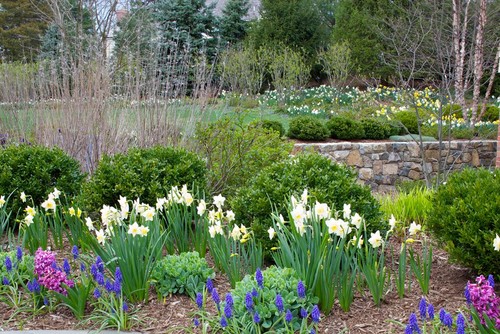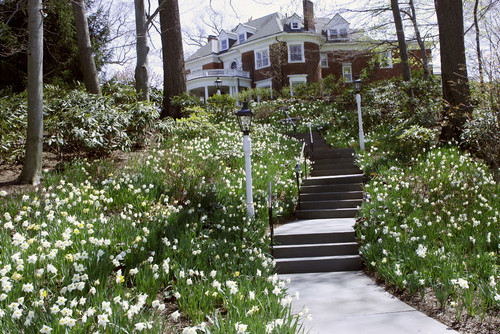Longtime readers will know that I'm not one to rush the seasons (other than winter, which I'm happy to mentally check out of sometime around January 5), but we need to talk about autumn. And maybe a little bit about spring. Because even though my garden is currently enjoying a very summerlike couple of weeks, the autumnal equinox is Friday, which means it's time to get serious about fall garden jobs.
 |
| Some of my favorite daffodils that I grew last year, including three split corona varieties and one multi-flowered variety. |
And among all the less-than-pleasant jobs (endless raking, anyone?) is one that I guarantee will bring you more satisfaction than any other: bulb planting. OK, so you'll have to wait a few months for the real satisfaction but I promise that there is nothing better seeing the first flowers pop up in spring when the rest of the world is gray.
Because I live in an area with a lot of deer and, more recently, a healthy rabbit population as well, I only plant bulbs that are critter resistant. I can protect my garden in summer from animal browsing by using animal repellents, but I'm not going to pull on my parka in late winter or early spring to go out and spray flowers. That means that my go-to fall-planted bulbs are daffodils and alliums, both of which I can all but guarantee won't be eaten by anything.
 |
| A naturalizing daffodil mix I planted in a wooded area last fall bloomed for months in spring, starting with these yellow trumpet daffodils before they gave way to all sort of other varieties. |
When planting almost any bulb, my advice is the same: think drifts, not dots. There is something so spectacular about swaths of flowers in spring. Some bulbs naturalize better than others, so last fall I planted a naturalizing mix in the woodsy area along the driveway. They were fabulous last spring, but I anticipate they will get even better as they multiple in future years.
 |
| An exotic and unusual double with orange accents. |
 |
| Daffodils are tough buggers, as this one that seemed intent on blooming through a nest of mayapples proved. |
There are "fancier" daffodils out there as well, and those I like to save for areas closer to the house where their finer details can be admired. The doubles look like roses, the miniatures are charming and sweet and those with reflex petals are downright intriguing. But last year I discovered a group of daffodils that really stole my heart: the split coronas. I can't explain why I had never paid much attention to this before, but last spring they were the real standouts for me.
 |
| 'Mount Everest' allium was a lovely addition to this part of the garden in early summer. |
If daffodils are the good-doers of spring, alliums are the statement pieces of early summer. Although they come in myriad forms and a handful of colors from deep purple to blue and snow white to pale pink (with the occasional yellow and maroon thrown in), all alliums do one thing better than any other flower: draw your eye. Be they tall like '
Globemaster' or '
Gladiator' or shorter in stature like 'Ivory Queen', just the form of alliums is an attention-getter. I let them stand in the garden long after their flowers have faded as even the dried flowers add important texture.
Quick aside:
Here's the how-to on my favorite way to plant bulbs. When you buy them in massive quantities as I tend to do, you have to find an efficient way to get them in the ground and this is fast!
OK, you're sold (as you should be!). But if you're expecting me to tell you to get out there and start planting, you're going to be disappointed. Because in most places in the U.S., it's still too early. You want your bulbs to have time to settle in, but you don't want them thinking, "Hey, it's go time!" I wait until there is a decided nip in the air, usually before a frost. That puts my personal bulb planting time around mid-October, although you can plant them right up until the ground is frozen if you really have to. So why the rush on talking about bulbs now? Because if you don't buy them now, all the good stuff will be gone by the time you do.
So here's me, telling you to shop. Seriously ... go for it, and I promise you will thank me come spring.
To help get you started,
Longfield Gardens has agreed to give a selection of daffodils and alliums to two lucky readers. I'll be giving away one
Naturalizing Daffodil Mix with 100 bulbs, perfect for creating a swath of gorgeous blooms that should multiple over the years, and one
Amazing Allium Mix with 63 bulbs of four varieties of alliums, including 'Christophii', which is a favorite of mine.
Enter using the widget below. There are a lot of ways to enter to maximize your chances, but if you're short on time all you have to do is log in and click and you're in!































